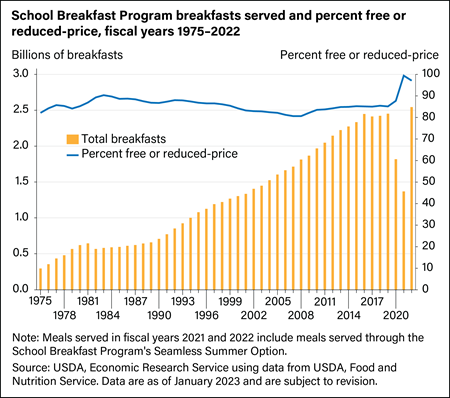
School Breakfast Program
The School Breakfast Program (SBP) provides low-cost or free breakfasts to children and typically operates in about 90,000 public and nonprofit private schools (grades Pre-Kindergarten–12) and residential child care institutions. In fiscal year (FY) 2019 (before the Coronavirus (COVID-19) pandemic), the program provided 2.5 billion breakfasts at a total cost of $4.5 billion.
USDA's Food and Nutrition Service (FNS) administers the SBP and reimburses participating schools and residential child care institutions for the meals served to students. Any student in a participating school can get an SBP breakfast. Students from households with incomes:
- At or below 130 percent of the Federal poverty line can receive a free breakfast.
- Between 130 and 185 percent of the Federal poverty line can receive a reduced-price breakfast.
- Above 185 percent of the Federal poverty line can receive a low-cost, full-price breakfast.
The onset of the pandemic in the second half of FY 2020 disrupted the provision of meals through the program by forcing schools to limit their operations. In response to these disruptions and to meet rising food needs during the pandemic, USDA issued waivers allowing for flexibilities in the implementation of the SBP and expanded the scope and coverage of the program’s Seamless Summer Option (SSO). USDA also created the Pandemic Electronic Benefit Transfer (P-EBT) program to reimburse families with children eligible for free or reduced-price school meals for the value of school meals missed due to pandemic-related disruptions to in-person instruction at schools. To learn more about pandemic-era changes to the SBP, please see:
- The Food and Nutrition Assistance Landscape: Fiscal Year 2020 Annual Report
- The Food and Nutrition Assistance Landscape: Fiscal Year 2021 Annual Report
- The Food and Nutrition Assistance Landscape: Fiscal Year 2022 Annual Report
- COVID-19 Working Paper: Filling the Pandemic Meal Gap: Disruptions to Child Nutrition Programs and Expansion of Free Meal Sites in the Early Months of the Pandemic
In FY 2020, the SBP provided about 1.8 billion meals, 87.7 percent of which were served free or at a reduced price. This share was 2.7 percentage points more than in FY 2019. In FY 2021, the first full year of the pandemic, the program provided 1.4 billion meals, 99.4 percent of which were served free or at a reduced price. In FY 2022, the program provided 2.5 billion meals, about the same as in pre-pandemic years. In that year, 97.1 percent of meals were served free or at a reduced price. The increase in the share of meals served free or at a reduced price in FY 2021 and FY 2022 is in part attributable to a USDA pandemic waiver allowing for meals to be provided free of charge to all students, regardless of their household’s income.
These waivers, along with most other Child Nutrition Program waivers, expired in the summer of 2022. The reintroduction of prices for some students may have increased hardship at a time when many households were still struggling with the economic consequences of the pandemic and its aftermath, such as rising inflation. A USDA, Economic Research Service (ERS) report found that a third of households with school-aged children that paid for school meals in December 2022 reported that doing so made it difficult for them to pay for other usual expenses. To learn more, please see:
A USDA, ERS-sponsored 2009 study found that elementary school-age students are more likely to participate in the SBP when they come from lower income or time-constrained households. Other ERS research found that the share of students receiving a free breakfast had increased over the prior decade. To learn more about participation in SBP, please see:
- The School Breakfast Program: Participation and Impacts
- Free School Lunch, Breakfast Participation Rose Between 2009 and 2019
Meals served through SBP must meet Federal nutrition standards, which were updated in the Healthy, Hunger-Free Kids Act of 2010 to more closely match the Federal Dietary Guidelines for Americans. Children with access to the SBP are more likely to eat breakfast in the morning, and ERS-sponsored studies found that, by increasing the likelihood that children would eat breakfast, SBP was associated with children having a lower Body Mass Index (BMI), a measure of weight status. Other ERS-sponsored studies have found that school meals contribute positively to the diet quality of participating students. To learn more, please see:
- School Meal Program Participation and Its Association with Dietary Patterns and Childhood Obesity
- USDA School Meals Support Food Security and Good Nutrition
- Schoolchildren Consumed More Whole Grains Following Change in School Meal Standards
- Trends in U.S. Whole-Grain Intakes 1994–2018: The Roles of Age, Food Source, and School Food
Additionally, participation in USDA’s child nutrition programs, including SBP, have been found to reduce food insecurity. To learn more about the impact of SBP on food insecurity, please see:
ERS has also investigated factors associated with a school's ability to serve healthy, appealing breakfasts within its cost constraints. To learn more, please see:
All figures are based on data available as of January 2023 and are subject to revision.
For the latest information on updates to the program during the COVID-19 pandemic, see FNS Responds to COVID-19.
Additional studies and information about program eligibility requirements, benefits, and application processes are available from the Food and Nutrition Service Child Nutrition Programs web page.
Download chart data in Excel format


